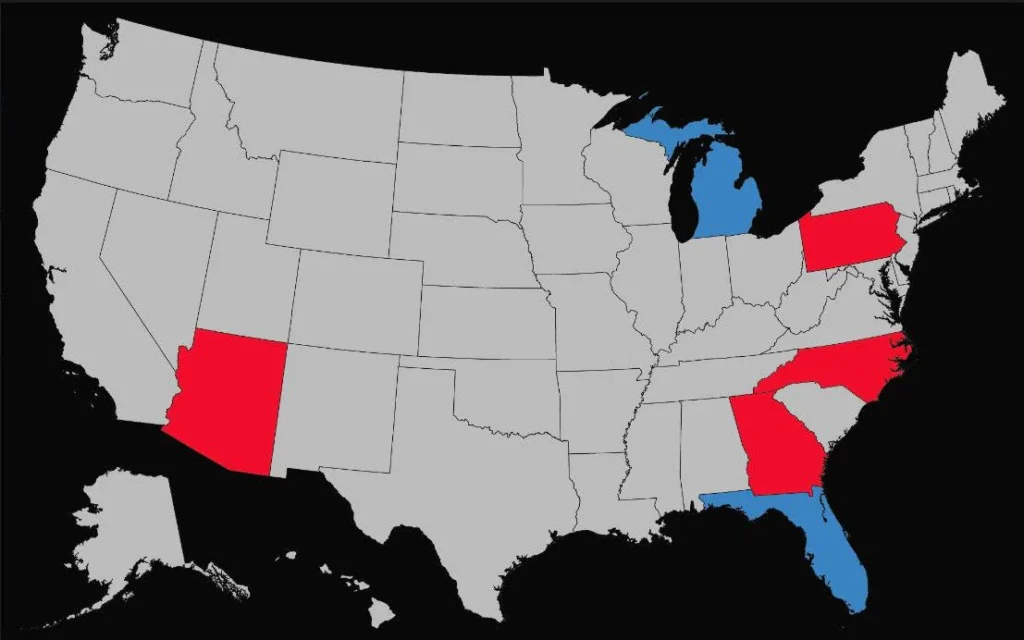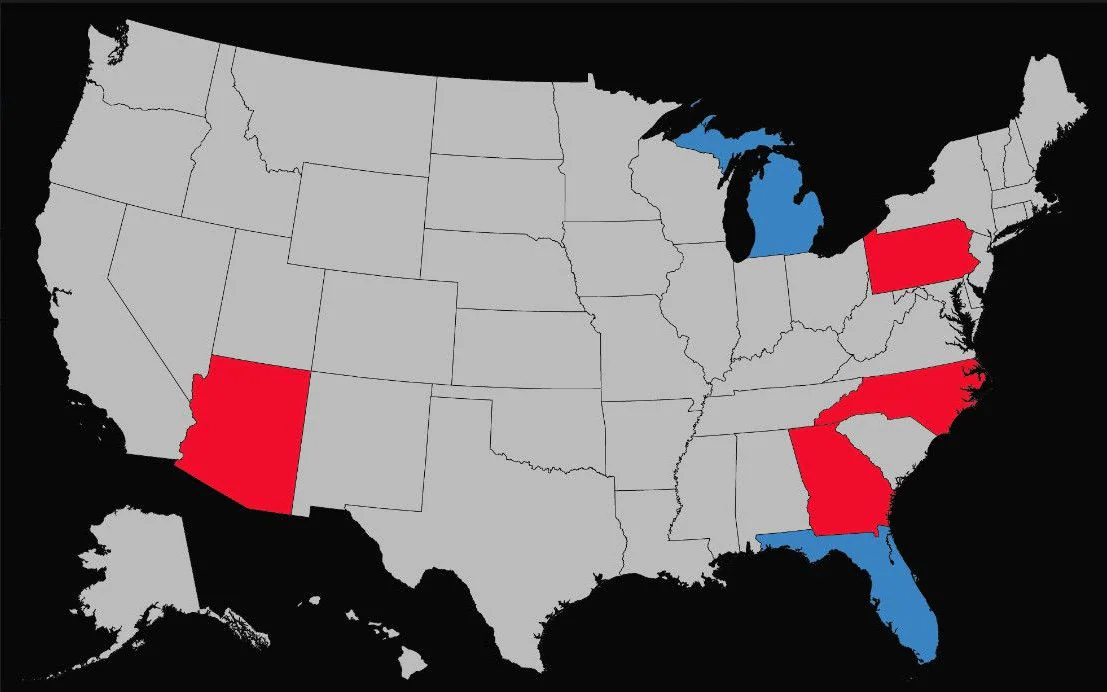
Overview
As the 2024 U.S. presidential election approaches, Vice President Kamala Harris is showing a strong lead in several critical battleground states, according to recent polls. This development is crucial as these states are likely to determine the outcome of the election. Harris’s campaign has gained momentum through her focus on key issues such as climate change, economic justice, and healthcare reform, which resonate with a broad base of voters.
Political Context
The Importance of Battleground States
Battleground states, also known as swing states, are crucial in U.S. presidential elections because they do not consistently vote for a single party and can swing either Democratic or Republican. States like Pennsylvania, Michigan, Wisconsin, and Arizona are often the focus of intense campaigning due to their ability to tip the balance in the Electoral College.
In the 2020 election, these states were fiercely contested, with narrow margins determining the winner. As 2024 unfolds, both the Harris campaign and her Republican opponent, former President Donald Trump, are investing heavily in these regions, knowing that victory here is essential for securing the presidency.
Polling Data and Analysis
Recent polls show Harris leading Trump by varying margins in several key battleground states. Her campaign has been particularly effective in the Midwest, where she has focused on issues like job creation, infrastructure, and climate change—areas that resonate with voters concerned about the economy and the future of manufacturing.
In Pennsylvania and Michigan, Harris has emphasized her administration’s efforts to revive manufacturing through green energy initiatives and support for union jobs. This approach appears to be paying off, as polls indicate that a majority of voters in these states trust Harris more than Trump to handle economic issues and believe she is better suited to lead the country through the next four years.
Campaign Strategy
Focus on Climate and Economy
Harris’s campaign has placed a strong emphasis on climate policy, particularly in states where climate change is having a noticeable impact. Her administration’s efforts to transition to clean energy and create green jobs have been central to her pitch to voters, especially in states like Michigan, where the auto industry is adapting to electric vehicle production.
This focus on climate is paired with a broader economic message aimed at addressing income inequality and supporting working families. Harris has proposed expanding access to affordable healthcare, increasing the minimum wage, and implementing tax## Perseid Meteor Shower Peaks Tonight
Overview
The Perseid meteor shower, one of the most spectacular and anticipated celestial events of the year, is set to peak tonight, August 11, 2024. This annual meteor shower is known for its high visibility and frequency of meteors, often delighting stargazers with dozens of meteors per hour under optimal conditions. The Perseids, as they are commonly known, originate from the debris left behind by Comet Swift-Tuttle and have been observed for centuries, becoming a major highlight for both amateur and professional astronomers.
Historical and Scientific Background
The Origin of the Perseid Meteor Shower
The Perseid meteor shower takes its name from the constellation Perseus, as the meteors appear to radiate from this area of the sky. The meteors are actually tiny pieces of the Swift-Tuttle comet, which last passed through the inner solar system in 1992 and will not return until 2126. As Earth crosses the comet’s orbital path, these small particles, often no larger than a grain of sand, enter our atmosphere at high speeds, burning up and creating bright streaks of light.
Comet Swift-Tuttle, discovered in 1862, is one of the largest objects known to repeatedly pass near Earth, with a nucleus approximately 26 kilometers in diameter. Despite its size, the debris it leaves behind is minuscule but abundant, leading to the impressive meteor showers observed every August.
The Perseids in Historical Context
The Perseid meteor shower has been observed for nearly 2,000 years, with some of the earliest recorded observations dating back to Chinese astronomers in 36 AD. Over time, the Perseids became known as “The Tears of Saint Lawrence” in Europe, due to their appearance around the time of the Saint’s feast day on August 10. This meteor shower has remained a staple in astronomical observations and a beloved event for those who enjoy stargazing.
Viewing the Perseids
Best Viewing Conditions
The 2024 Perseid meteor shower is expected to be particularly impressive due to favorable viewing conditions. With the new moon having just passed on August 7, the sky will be especially dark, providing an optimal backdrop for observing even the faintest meteors. Under ideal conditions, viewers could see between 50 to 100 meteors per hour, although this number can vary depending on the level of light pollution and cloud cover in different regions.
Stargazers are advised to find a location away from city lights to fully experience the shower. Rural areas, national parks, and dark-sky reserves are among the best places to observe the event. In addition to the meteors, viewers might also see other celestial objects, such as planets and the Milky Way, making for a rich stargazing experience.
Viewing Tips and Techniques
For the best experience, it is recommended to face the northeastern sky, where the constellation Perseus will rise during the late evening. However, meteors can appear anywhere in the sky, so a wide, unobstructed view is ideal. Stargazers should allow their eyes to adjust to the darkness for at least 20 minutes and avoid using bright lights or looking at screens, as this can reduce night vision.
Bringing a reclining chair or blanket can help make the experience more comfortable, as viewers may spend several hours outside to catch the peak activity of the shower. While no special equipment is needed to view the meteors, binoculars or a telescope can enhance the overall stargazing experience by allowing viewers to see other celestial objects in greater detail.
Organized Viewing Events
Across the United States and other parts of the world, numerous organized events are being held to celebrate the Perseid meteor shower. National parks, observatories, and local astronomy clubs are hosting viewing parties, where participants can gather to watch the meteor shower and learn more about astronomy. These events often include expert talks, guided stargazing sessions, and opportunities to use telescopes to view distant stars and planets.
For those unable to attend an in-person event, several online platforms and observatories are offering live streams of the meteor shower, allowing people to enjoy the event from the comfort of their homes. These streams often include commentary from astronomers and other experts, providing educational insights into the science behind the Perseids.
Cultural Significance
The Perseid meteor shower has a special place in both scientific and popular culture. Throughout history, the Perseids have been associated with various myths and legends, particularly in Europe, where they were linked to the martyrdom of Saint Lawrence. In modern times, the Perseids have become a symbol of the beauty and wonder of the night sky, inspiring countless works of art, literature, and even music.
The annual nature of the Perseid meteor shower makes it a tradition for many families and communities, who gather each year to watch the night sky light up with meteors. This event not only provides a connection to the natural world but also serves as a reminder of our place in the cosmos.
Sources
- NASA
- Space.com
- Sky & Telescope
- The New York Times
- EarthSky

